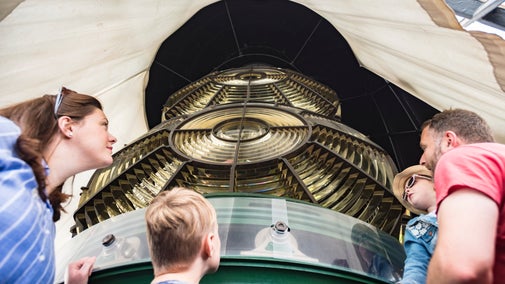
Souter Lighthouse's collections
Explore the objects and works of art we care for at Souter Lighthouse on the National Trust Collections website.

Souter Lighthouse has proudly stood on the coast midway between the Tyne and the Wear since 1871, leading the way in a new generation of electric lighthouses. The area around the lighthouse was a hive of industry, with a colliery and an entire workers’ village. Although these have been lost to time, there are plenty of stories to uncover on a visit to Souter Lighthouse and The Leas.
Built in 1871 to warn ships of the dangerous rocks at Whitburn Steel, Souter was the first lighthouse in the UK, and one of the world's first, purpose built to use electricity. Souter was a technological marvel in its day, but the development of new technology such as GPS and satellite navigation led to its decommission in 1988 after 117 years of service.
The best coal in the North East was found in seams extending out under the North Sea. Whitburn Coal Company sunk two shafts south of the lighthouse between 1874 and 1877 and the first coal was brought out in 1881. By 1898 it was producing 2,600 tonnes of coal each day. Mining at Souter was never easy though, and the colliery finally closed in 1968. The reclaimed land is now Whitburn Coastal Park.
You wouldn't think it today but the grassed area north of Souter Lighthouse was once a thriving community. The village of Marsden was built in the 1870s to house workers from Whitburn Colliery and their families. At its peak, a church, Methodist chapel, shop, post office, school, Miners’ Institute, allotments and a welfare field served the 700 or so residents.
The pit closed in 1968 and the village was completely demolished soon afterwards, with its residents moved to new, modern council houses in nearby Whitburn.
Lewis Carroll, the author of Alice in Wonderland, had family connections with the area. His sister was married to Reverend Collingwood, the vicar of Southwick and his cousin was married to the Vicar of Whitburn.
While he was staying at Whitburn he wrote The Walrus and the Carpenter, which was published in Alice Through the Looking Glass in 1872 - the year after the lighthouse came into service for the first time.

Explore the objects and works of art we care for at Souter Lighthouse on the National Trust Collections website.

Find out what to see and do on a visit to Souter Lighthouse and The Leas. Climb the lighthouse, explore the rock pools and discover this haven for wildlife.

Find out about nature conservation at Souter Lighthouse and The Leas and discover how our work has helped save three rare bird species from further decline.

Discover where to eat, drink and browse for second-hand books during a visit to Souter Lighthouse and The Leas.

Find out what family activities you could get involved with on a visit to Souter Lighthouse and The Leas
Learn about the creation of a new conservation centre close to Souter Lighthouse and The Leas, where visitors can explore wildlife and heritage.

Learn about people from the past, discover remarkable works of art and brush up on your knowledge of architecture and gardens.